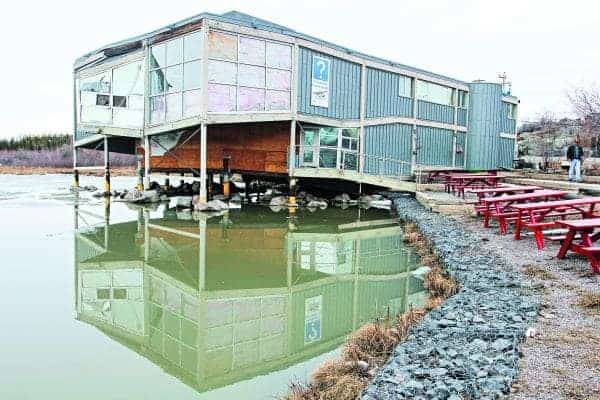Two years after the Northern Frontier Visitors Centre was shuttered, its future remains uncertain.
Built in the 1990s, the building was a place where tourists could find information and assistance before it was closed due to enormous structural problems in 2017. The Northern Frontiers Visitors Association, which operated the centre, disbanded shortly thereafter.
At the time, it was estimated that the GNWT would need to spend up to $5.25 million to save its sinking structure. Frost heave had caused the walls and windows of the building, which was built on a marsh overlooking Frame Lake, to buckle and crack.
The city's visitor information services were moved into the Prince of Wales Northern Heritage Centre and then the basement of Yellowknife City Hall. That was expected to last only until last September.
Handing out Yellowknife brochures and directions to tourists, the temporary centre is still a placeholder for an industry built to grow. In 2017-18, roughly 112,530 visitors arrived in the territory and spent $203.4 million, according to figures released by the territorial government in May. By next year, 85,000 visitors are expected arrive in Yellowknife alone, injecting $300,000 per day into the local economy, according to the visitor's services strategy published last year.
According to figures provided by Industry, Tourism and Investment Minister Wally Schumann, 7,105 visitors stopped by the City of Yellowknife's ground floor tourism information centre in 2018, followed by 12,991 people as of March of this year.
Those figures are dwarfed by the more than 50,000 people who visited the Northern Frontier Visitors Centre in 2016 – its last full year in operation.

NNSL file photo
People have continued to journey north to hunt, fish, view the aurora and tour the city. However, despite the potential economic gains from tourism, the hulking remains of the city's visitors centre have sat idle on Frame Lake while city planners have been working on a solution.
In its 2018 publication, the city's Visitors Service Strategy concluded "that the best approach is to pursue opportunities to work with a city-based business or organization in a co-location approach within the downtown city core."
Plans on how this approach can best support visitor services, and a destination marketing organization – which is to be created following the Short Term Accommodations bylaw – will come to city council at some point, stated city spokesperson Richard McIntosh by email.
A hotel levy – which several municipalities have implemented across the country at a typical rate of two to five per cent – would appear on visitors' hotel bills. There's also a chance the tax could apply to bed and breakfasts.
The extra money would go toward funding the marketing organization to promote tourism in the territory, which a City of Yellowknife tourism site estimates would cost $1 million.
With a currently proposed levy of two to four per cent, the site estimates the annual collection would be between $750,000 and $1.5 million.
Without the tax, it could be "very difficult" to promote tourism, the tourism site states. "That will mean slower economic growth for Yellowknife, fewer new job opportunities and less money circulating through the Yellowknife economy."
'If we end up ripping this building down'
Meanwhile, on the shores of Frame Lake, the old centre sinks on its pilings. Last spring, the GNWT spent $125,000 repairing its supports and pilings, and fencing it off. Nonetheless, its future is as murky as it was a year ago.
In May, Schumman told MLAs there were three concepts as part of the planning process for the building but worried it might not have a viable future.
"My concern is: is it going to be to a point of non-repair? Do we have to knock this thing down? I think that the reports that we are going to get are going to give us a little better of an idea of what is going on," Schumman said in the legislative assembly.
Saving the building was "not looking very well," he said, explaining repairs could be too expensive to be viable.
The city receives $161,000 annually from the GNWT to support visitor services. The old building may not survive to see what happens next.
"If we end up ripping this building down, the 19th Legislative Assembly is going to have to make a decision about how we are going to move forward," Schumman said.